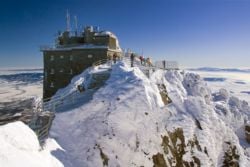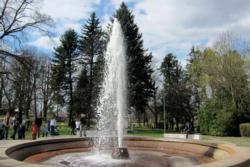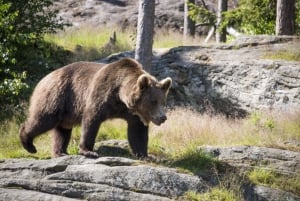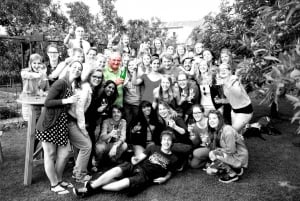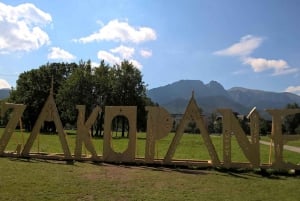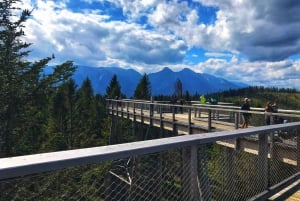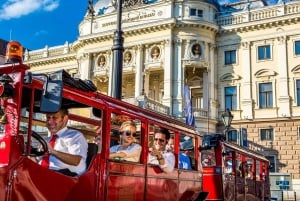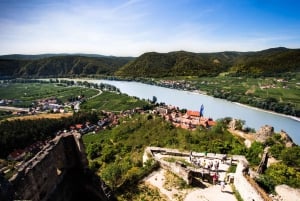Top 15 Attractions
As a national cultural monument, the tremendous Spiš Castle with its area of more than 4 ha (9.9 ac), and partially in ruins, is one of the largest castle compounds in Europe! Spiš Castle was inscribed on the UNESCO World Heritage List in 1993.
Construction of the medieval castle on a travertine hill dates back to the beginning of the 12th century. The oldest written reference to the castle is from 1120. At the beginning it was a boundary fort placed at the northern frontier of an early feudal Old Hungarian state. Afterwards, it became the seat of the head of the Spiš region for many centuries. In the second half of the 15th century the reconstruction of the castle fell upon its new owner Štefan Zápoľský whose intention was to remake it into a stately aristocratic residence. He had made a palace, a knight hall and chapel of St. Elisabeth in the castle. His son Ján, later King of Hungary was born at the castle. Read more...
The real gem of Slovakia is the marvelous, fairy-tale Bojnice Castle, one of the most beautiful as well as most visited castles not only in Slovakia but also in Europe. The castle in Bojnice is the unique architectural building stylized in Romantic style of the 19th century. But archive documents about the fort were dated from the beginning of the 12th century.
The basic forms of the castle are Gothic, the biggest renovating works were performed in the 16th century by the Thurzo family. The beginning of the radical rebuilding was realized in 1889 by the Pálffy family, mainly by Ján Pálffy, who has led it rebuilt to the present form. Then an architect Jozef Hubert used the patterns and the elements of French Romanticism. In this style there are furnished palatial interiors with rich historic furniture, historic weapons and artistic collections. Read more...
Ochtinská Aragonite Cave represents a unique natural phenomenon drawing attention by the richness and variety of aragonite fill, as well as an interesting evolution and development of cave spaces.
Due to its significance and unique ornamentation, it was included into the UNESCO List of the World Cultural and Natural Heritage. To see the complete list including the rest of the total number of 6 UNESCO listed caves click here.
It is formed in a lens of Palaeozoic Devonian crystalline lime stones situated amidst non-karst rocks – phyllites. The entrance adit opens to cave spaces at 642 m (2,106 ft) above the sea level. Wedge upwards narrowing passages and halls were formed by corrosive activities of rainfall waters, which percolated along the distinct tectonic faults. Different shape have mainly horizontal passages and halls, which are located between tectonic faults. Read more...
The easternmost Gothic cathedral in Europe, the largest church in Slovakia, and of course, the pride of the city of Košice. The symbolism of the city's patron is evident as soon as you visit St. Elisabeth's Cathedral. Construction work on the Cathedral started around 1380. It is the furthest east western-style gothic cathedral in Europe, as well as the biggest temple of worship in Slovakia.
It houses the fascinating Altar of St. Elisabeth, a rare gothic double spiral staircase - one of just five of its kind of Europe, the crypt of the leader of the biggest anti-Habsburg uprising in the former Kingdom of Hungary, Ferenc Rákóczi II, and also a sundial from 1477.
The frescos and sculpting are the work of Master Štefan, a local artist from the 15th century which adorn its interior and exterior. Read more...
ORAVA CASTLE
The most attractive tourist locality of the northern Slovakia is the fascinating Orava Castle, lying on the river Orava near the village Oravský Podzámok, below impressive cliffs.
In 1370, it became a county castle and the seat of the Orava Castle estate, which included almost the whole region of Orava. The castle, much like others in Slovakia, stands on the site of old wooden forts and it was constructed after the Tartar invasion in 1241. Originally, it was built in the Romanesque and Gothic styles and later reconstructed in the Renaissance and neo-Gothic styles.
It consists of several buildings copying the shape of the castle rock. In 1556, the castle fell into the hands of the Thurzos who were the authors of the most extensive reconstruction of the castle's history. The Orava Castle acquired its present form in 1611. Read more...
LOMNICKÝ PEAK (LOMNICKÝ ŠTÍT)
Discover the beauty of Lomnický Peak at 2,634 m/8,642 ft above sea level!
Monumental and elegant Dedo, the name given by old inhabitants of the Tatras to the Lomnický Peak, has been the highest peak of the High Tatras since time.
The Lomnický Peak lost its primacy of the highest peak in 1837. Despite this it still remains 'The King of the Tatras', named by neighboring Poles, the most famous and the most beautiful peak of the Tatras.
ASTRONOMICAL CLOCK (SLOVENSKÝ ORLOJ)
The village of Stará Bystrica is located in the northwestern part of Slovakia. It is the home to the world's youngest astronomical clock. During the reconstruction of the square, an astronomical clock was built in the village.
The astronomical clock has the shape of a stylized form of Our Lady of Sorrows, patron of Slovakia. It has been described as the largest wooden statue of Slovakia and its exterior is decorated by statues of important figures from Slovakia's history, such as Prince Pribina, King Svätopluk, Anton Bernolák, Ľudovít Štúr, Milan Rastislav Štefánik and Andrej Hlinka. Each hour, statuettes of saints related to Slovakia appear - Cyril, Methodius, Andrew-Zorard, Benedict, Gorazd, Bystrík and Adalbert.
The astronomical part of the clock consists of an astrolabe displaying the astrological signs, positions of the Sun and Moon, and the lunar phases. The clock is controlled by computer using DCF77 signals.
COURTYARD OF EUROPE IN KOMÁRNO
The buildings in the new square with a surface of 6,500 m² (7,774 yd²) are stylistically designed and they represent historical architecture typical for particular parts of Europe.
The splendid historical center of Komárno, a town situated in the south of Slovakia, on the bank of the river Danube, and the Courtyard of Europe are linked by entrance gates: the Gate of St. Stephen, the Gate of Belo IV and the Gate of Maria Theresa.
The gate of Matthias I opens from the side of the inner park of the Zichy Palace. Mathew I was the best-known king in our history, who was closely emotionally connected with the town of Komárno. This gate is one of the landmarks of the courtyard. With its shape and colors, it reminds the buildings built during the reign of Matthias I.
In the middle of the square stands a functional copy of the original well which used to stand in the main square, in front of the Town Hall until 1878.
GEYSER OF HERĽANY
In the 1870s, an artesian well was drilled here in pursue of another mineral water source for the expanding spa. The 405 m (1,327 ft) deep probe brought up a strong spring of the mineral water. Now the periodicity of emanation is about 32-34 hours. The water springs for about 20-30 minutes to the height of maximum 20 m (65 ft). The yield of one eruption is about 600 hl (15,850 gallons) of water.
As this unique natural scene occurs approximately every one and a half days, therefore tourists should enquire by phone at the local authority about the presumed time of its appearance or just simply click on the website link.
The Geyser of Herl'any is a property of cultural and natural heritage which is designed to be inscribed on the UNESCO World Heritage List.
BISON MENAGERIE IN TOPOĽČIANKY
There is only one place in Slovakia, hidden in beautiful oak forests, where one can see Europe's largest mammal, the European bison, 'a close relative' of more known, the North American buffalo.
The bison as the biggest mammal, can reach 2.7 m (8.85 ft) in length and 1.9 m (6.23 ft) in height, the bull can weight as much as one and a half ton and live as long as 30 years. The mating season is in August and September and the cow usually gives birth to a single calf. According to an international treaty, all bisons born in Slovakia receive names beginning with Si – Sibirka, Sigmund, Sivko, Silan, Silvo etc.
This massive animal was once a natural part of Europe's forests and it could be found living freely as late as in the 19th century, a fact proven by numerous place names in Slovakia for instance Zuberec, Zubrohlava, Zubrá etc. Read more...
The picturesque, natural lake Morské oko (Sea Eye), called Great Vihorlat Lake in the past, and located in the deep beech forests of the Vihorlat Mountains is a reminder of a volcanic activity of the mountains, and is unparalleled among the volcanic mountains in Europe!
The formation of the lake Morské oko falls within a period of volcanic activity in the region. A massive landslide on the eastern slopes of Motrogon and Jedlinka blocked the valley of the brook Okna, and behind this barrier a natural lake arose. Morské oko is situated at an altitude of 618 m (2,027 ft). Its length is about 750 m (820 yd), depth is 25-28 m (82-88 ft), and is fed by 6 streams and several periodic flows. The excess water from the lake is lead away by the brook Okna. Read more...
The most important as well as most unique monument of the town of Levoča is the St. Jacob Church with its 11 Gothic and Renaissance wing altars, including the highest wooden Gothic altar in the world!
Only two towns in Europe - Levoča and Bardejov (both UNESCO towns) can boast of a collection of twelve Gothic altars of own provenience, standing mostly on original locations.
The unique late Gothic altar of Virgin Mary and St. Jacob the Apostle was constructed in the workshop of Master Paul of Levoča in the years 1507 to 1518. It is made of lime wood and its height is 18.6 m (61 ft), and its width is 6.2 m (20.3 ft). It fills out the sanctuary space from floor to vault.
The entire system is composed by circles and triangles, and therefore it appears extremely balanced. Each thing has its place precisely defined. The main statues in the altar box represent Madonna with a child in her arms, standing on a half moon with the head of a demon; St. Jacob and St. John, already in heaven. Read more...
HISTORIC TOWN OF BANSKÁ ŠTIAVNICA
The old medieval mining center grew into a town with Renaissance palaces, 16th-century churches, elegant squares and castles.
Its undeniable values and beauty caused that it is one of the first Slovak towns that was inscribed on the UNESCO World Heritage List in 1996.
HISTORY
Extraction of precious metals in central part of the mountains Štiavnické vrchy enjoys a very long history. The area was first mentioned in the document from 1156 as terra banensium or the land of miners. Silver ore prevailed among the mined metals and Banská Štiavnica won the attribute of 'silver town'.
Banská Štiavnica progressively became the biggest mining center in the Habsburg Monarchy in the 18th century. Read more...
Bardejov is an exceptionally complete and well-preserved example of a fortified medieval town, which typifies the urbanisation in this region.
The town of Bardejov with a population of 33,400, situated in the eastern part of Slovakia, was rightly awarded the European award, gold medal of ICOMOS Foundation of UNESCO in 1986, and it was inscribed on the UNESCO World Heritage List in 2000.
Attractiveness of Bardejov is enhanced by the pleasant landscape with numerous landmarks. In the calm valley of the brook Bardejovský potok on the southeastern foothill of the Flysch mountain of Busov the spa of Bardejov is located. The town administers it. Museum of Popular Architecture (Múzeum ľudovej architektúry) situated in the upper part of the spa, where 28 folk buildings from the upper part of the Šariš and the north of Zemplín region have been gathered.
The town was referred to in the Ipatievsky annals in 1241 as the market settlement of Bardouev. Read more...
Specific samples of sacred architecture in Slovakia are the wooden churches. Their folk builders expressed the perfect harmony of the human soul with nature and the effort to disengage from earthly worries.
Wooden churches of the Slovak part of Carpathian Mountain Area, which were added to the list of UNESCO World Heritage Sites in 2008, possess an extraordinary worldwide value. Those are the Roman Catholic churches in Hervartov and Tvrdošín, Evangelical articular churches in Hronsek, Kežmarok and Leštiny, and churches of Eastern rite in Bodružal, Ladomirová and Ruská Bystrá.


